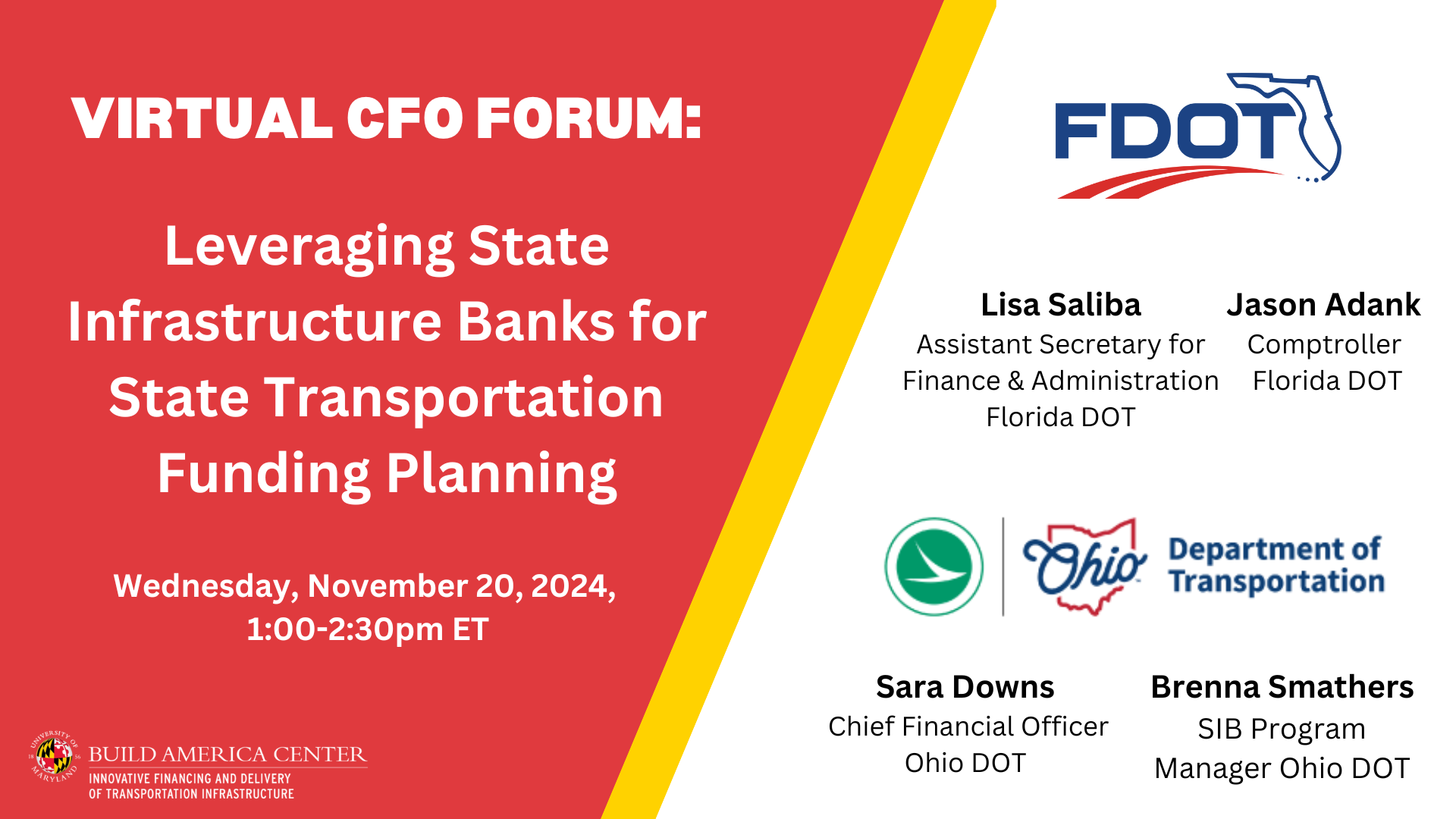Don’t miss this upcoming event featuring panelists from Florida and Ohio state DOTs.
TOPIC: Leveraging State Infrastructure Banks for State Transportation Funding Planning
DATE: November 20, 2024
TIME: 1:00 – 2:30 pm ET
FORMAT: Zoom Webinar
EVENT SUMMARY:
On November 20, 2024, the Build America Center (BAC) at the University of Maryland hosted the Virtual CFO Forum: Leveraging State Infrastructure Banks (SIBs) for State Transportation Funding Planning. Moderated by Peter J. Mancauskas, Acting Director of the Office of Performance and Innovative Finance at the Federal Highway Administration (FHWA), the forum brought together experts from the Ohio Department of Transportation (ODOT) and the Florida Department of Transportation (FDOT). This engaging session included 62 participants who explored strategies for maximizing the effectiveness of SIBs in transportation financing. The forum provided valuable insights into operational frameworks, innovative uses of SIBs, and best practices for state-level transportation funding.
Ohio DOT: Leveraging SIBs for Accelerated Infrastructure Development
Representatives from ODOT, including Brenna Smathers and Sara Downs, detailed Ohio’s SIB program, which provides loans to local governments and organizations to advance critical infrastructure projects. Highlights of their presentation included:
- Program Functionality: The Ohio SIB enables municipalities and Metropolitan Planning Organizations (MPOs) to access federal funds earlier, advancing projects without waiting for federal allocations. Loans are repaid through future federal allocations such as CMAQ and SDBG funds.
- Case Study: I-71 Interchange at Martin Luther King Drive, Cincinnati: A $25 million SIB loan funded this $117 million project, which was completed on time and fully repaid by 2024. The project improved traffic flow, safety, and connectivity in the area.
- Loan Repayment Structure: Local governments handle interest and fees, while ODOT manages principal repayment using federal allocations. This collaborative arrangement ensures timely payments while fostering local ownership.
During the Q&A session, panelists discussed topics such as repayment timelines and the use of tolls or user fees in repayment agreements. Brenna clarified that while tolls are not used for repayment in Ohio, deferred repayment terms are structured into loan agreements to accommodate project timelines.
Florida DOT: SIB Innovation and Management Flexibility
Representatives from FDOT, including Lisa Saliba and Jason Adank, highlighted Florida’s dual federal and state SIB programs and their innovative approaches:
- Historical Leadership in SIB Implementation: Florida was among the first states to pilot the SIB program under TEA-21. Legislative changes ensured the program aligned with state financial laws.
- Gap Financing and Emergency Loans: Florida’s SIBs focus on gap financing to complement other funding sources. Emergency loans are available for urgent needs, such as hurricane recovery projects. For example, FDOT is currently evaluating financing for airport repairs following Hurricane Helene.
- Unique Management and Flexibility: Unlike Ohio, Florida’s SIBs are not committee-driven but operate as a program with negotiable interest rates and repayment terms of up to 35 years. User fees and tolls are permissible repayment sources, adding flexibility.
- Strategic Capitalization: Recent federal SIB capitalization of $50 million, facilitated through FHWA and federal funds redistribution, underscores Florida’s innovative funding strategies. This capitalization provides revolving loans for projects eligible under Title 23, maximizing state and local infrastructure investment.
Jason Adank emphasized the importance of strategic capitalization and collaboration with FHWA to ensure the program’s success. He highlighted that Florida’s SIB program has issued 64 loans totaling over $1.5 billion, supporting more than $10 billion in infrastructure projects.
Key Themes from the Panel Discussion
The panel discussion brought forward several important themes:
Marketing and Awareness: Both Ohio and Florida identified challenges in raising awareness about SIB programs. Limited loan funds make sustained marketing difficult, yet broader outreach is essential for engaging local governments and smaller project stakeholders.
National Promotion of SIBs: BAC is investigating ways to enhance SIB outreach as a national initiative. Collaboration with state DOTs and local governments could improve awareness and utilization of SIBs, particularly for newer or smaller programs.
Stakeholder Contributions:Panelists encouraged participants to share experiences and strategies for improving SIB utilization. Collaborative forums like this one provide a platform for identifying solutions and replicable best practices.
BAC’s Role and Future Steps
Dr. Qingbin Cui highlighted BAC’s efforts to support SIB programs through resources, workshops, and technical assistance. BAC’s partnership with FHWA aims to address knowledge gaps and expand the impact of SIBs nationwide. Moving forward, the CFO Forum will reconvene to explore additional topics and gather insights for continuous improvement.
Conclusion
The Virtual CFO Forum highlighted the critical role of SIBs in advancing transportation infrastructure projects. Through shared experiences from Ohio and Florida, participants gained valuable insights into innovative financing mechanisms, repayment structures, and strategic capitalization. BAC and FHWA remain committed to supporting SIB administrators and fostering collaboration among states to maximize the potential of these programs. This forum marks a significant step in strengthening transportation funding strategies nationwide.



